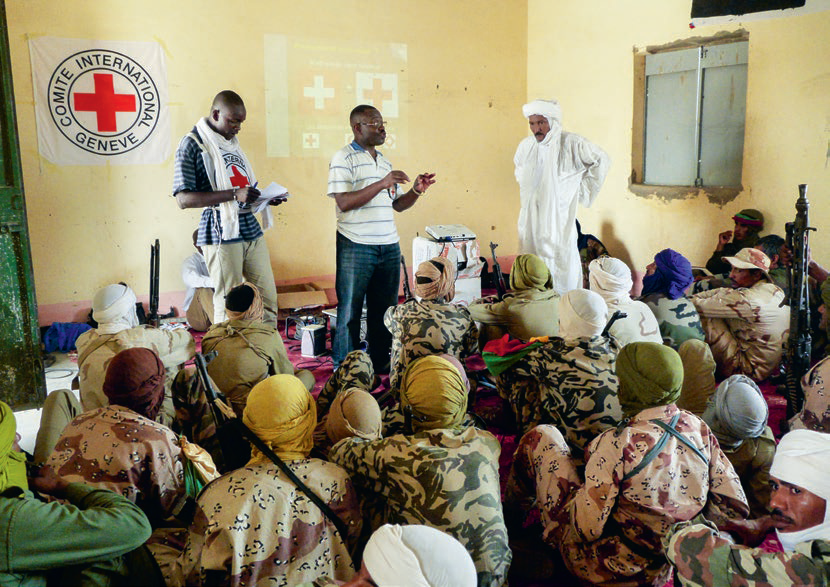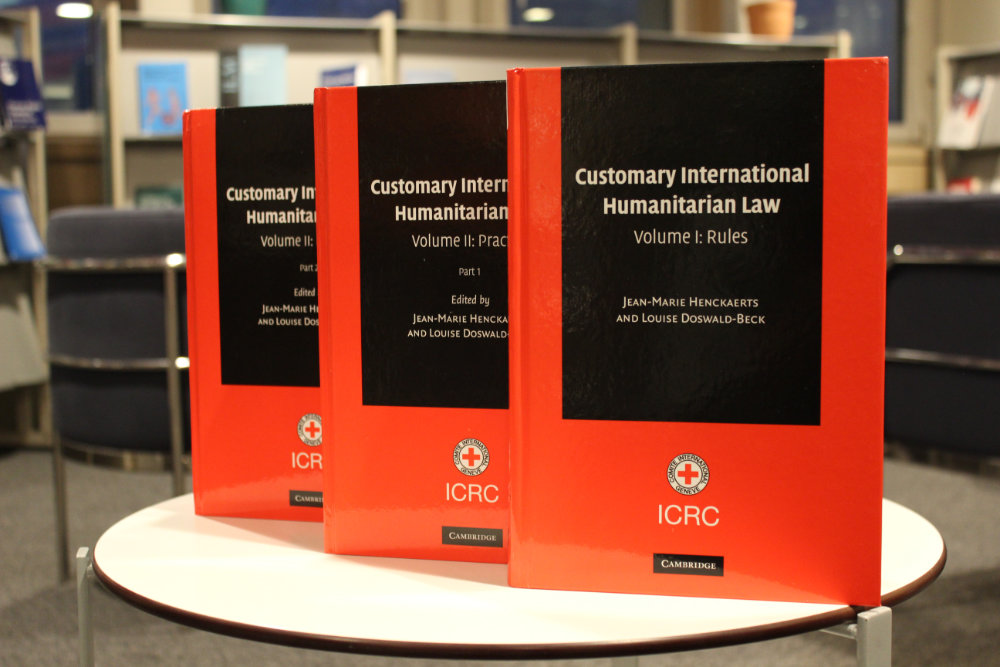Armed conflicts cause immense suffering. The best case scenario is to prevent them from occurring in the first place. However, when armed conflicts do occur, some of the devastating consequences on civilians and those no longer taking part in hostilities can be mitigated. This can be achieved in part if parties to conflict, States and non-State armed groups know, accept and respect their obligations under international humanitarian law, or IHL.
Efforts to get parties who display harmful behaviour to change so that civilians are spared is nothing new and, in the case of the International Committee of the Red Cross (ICRC), go back to its very origins. Since then, our thinking has evolved, and we have learned to harness and build upon existing experience while also exploring new technologies and new methods.
Why influencing matters
We cannot assume that people carrying weapons fully understand international humanitarian law or other legal frameworks and – moreover – the practical application of rules on the battlefield. A key element of influencing is thus ensuring that combatants not only know the limits that the law sets, but understand its practical application and integrate it into their doctrine, training and operations.
However, beyond knowledge, understanding and integration, we know too well from experience that being aware of the law does not equal acceptance of or respect for it. We know that international humanitarian law is regularly violated – by mistake, but clearly also by design – and civilians are paying the price for it. Understanding the roots of behaviour as well as the roots of restraint of weapon bearers in conflict can help us understand some of the processes and mechanisms influencing behaviour. Such knowledge can then inform the way humanitarian organizations engage with weapon bearers, but also others who wield influence to reinforce compliance and change harmful behaviour.
How to go about influencing?
For the ICRC, the proximity to populations affected by armed conflict and violence is a critical aspect of our work. This proximity enables us to work with communities and better understand their needs and grievances. Another critical element is the proximity to armed actors and decision-makers whose behaviour and decisions may or may not result in harm. This includes contacts with State armed forces and non-state armed groups and decision-makers in the field, as well as contacts with high-level State authorities and diplomatic contacts. Engagement with these actors is important to help us understand their motivations, who influences their decisions and behavior (for example other actors, political authorities, communities), identify what levers of influence may exist (for example religion, values) and what their challenges might be.
In combining the operational experience, technical expertise, evidence-based research, diplomatic network and contextual knowledge with the relevant internal and external information and data in a multi-disciplinary approach, we identify harmful behaviour and ways to address it as well as sources of restraint and how to promote them. To that end, we draw on the expertise of colleagues in the areas of law, policy, protection, the military and police, security, diplomacy and communication. The ICRC tries to influence decision-makers to enhance respect for the law through a confidential bilateral dialogue on protection issues, multilateral/bilateral diplomacy, dissemination sessions, training, public communication or digital diplomacy.
While we may be able to fall back on our specific experience, gaps in knowledge and expertise of course remain. Over time, we have built up our skills when it comes to analysis around conflict dynamics, as well as those relating to individual vulnerabilities as in the case of detainees. However, where we need to improve significantly is in our understanding of the social and power relations in the population and community at large. We do not yet systematically analyze social factors on the community level such as diverse vulnerabilities and capacities, as part of our context analysis. Doing this consistently will complement our understanding of how harmful behaviour impacts civilians, thus enabling us to better tailor our response to prevent it.
What areas and who do we seek to influence?
There are broadly three areas we seek to influence: law, policy and practice/behaviour. They are distinct but interrelated. A robust legal system and an integration of obligations under international humanitarian law into domestic legislation by parliamentarians are a sound basis from which related policies can be developed. Judges and prosecutors should be aware of and understand the laws in order to apply them. As for armed forces, understanding and integrating the law into doctrine, conduct and training are critical. Academics at universities and communication to the public at large should reinforce the understanding and acceptance of international humanitarian law.
At least, this is what should happen in an ideal world. In reality, however, legal obligations are not necessarily mainstreamed this smoothly. It is therefore critical to work on all three areas simultaneously, with different methods, different messaging, different speeds, but always with the same message: respect and ensure respect for international humanitarian law to prevent human suffering.
It is critical to engage with a wide range of stakeholders. Each one plays a different role when it comes to the development, adoption or execution of the law, drafting of a policy or indeed adhering to the law in combat. And just as with the three areas – law, policy, behaviour – here too, we will not engage with all stakeholders at the same time or the same place, but rather tailor our engagement to the specific issue we are trying to address.
Techniques and technologies
Increasingly, the ICRC has been looking at using technology and techniques with which we can enhance our ability to influence. For example, we are exploring behavioral science techniques, such as nudging, in a handful of different areas, considering how findings can be applied with an ICRC focus, such as in the area of prevention and mitigation of violence against health providers, energy consumption and beyond. Increasingly, innovative technologies and approaches, such as virtual reality and computer games, are being tested to reach different audiences and influence behaviour change to increase respect for international humanitarian law alongside the more traditional though tried-and-tested approaches.
During the 33rd International Conference, participants were introduced to a virtual battlefield and guided through shoot or no-shoot and other behavioural scenarios related to IHL. Understanding the strength and added value of each approach, separately or in combination, will ultimately yield the best result.
None of these approaches will be very successful if there isn’t a strategy behind them. It starts with clearly identifying the problem we are trying to address. Questions such as, ‘what are the root causes of harmful behavior?’, ‘what are the sources of restraint and how can we promote them?’, ‘how can we measure the impact of our activities?’ or ‘how much of our effort actually contributed to a change in behaviour?’ are critical in elaborating an influencing strategy. Any progress is unlikely to be linear, e.g. ‘if I do X, then Y will happen’. Also, linear thinking is helpful in lots of places, but does not describe how political or social change happens. Change is most likely to be complex, unstable, non-linear, beyond control and incremental. And more often than not, change will take time, sometimes a long time. This may sound like common knowledge, but is it necessarily common practice?
Combining a robust understanding of risks, vulnerabilities and coping mechanisms of affected people with a solid understanding of the perspective of actors whose behavior and decisions may result in harm, and using the techniques and technologies at our disposal, we should be able to adapt our influencing strategies to be more effective.
A word on measuring impact
Measuring the impact of influencing efforts is challenging. For one, how does one measure the absence of something? For example, how do we know that our efforts to influence combatants resulted in the prevention of further suffering? In other words, was there a deliberate action to limit the use of violence and did we contribute to that action? It might be easier to say when humanitarian organizations have contributed to a change in legislation, but even here pinpointing exactly where the individual organization made a difference is challenging.
There is then the vexed question of attribution versus contribution. When do we know that a result can be directly attributed to us? Most probably, we will have contributed, together with many others, to the result. That said, identifying indicators (qualitative, quantitative), monitoring changes, using interim markers, analyzing outcomes and empirically testing approaches are important areas to work on and help in improving and adjusting our current and future strategies.
Way forward
Influencing behaviour in armed conflict is an ancient activity. The idea is not to re-invent anything. It is rather about strengthening what we are already doing, but doing it more deliberately, consciously, systematically and coherently. It is about building on the knowledge we already have while exploring new and innovative approaches. This is not about introducing a new toolset; it is about expanding our mindset.
See also
- Fiona Terry & Brian McQuinn, Behind the scenes: The Roots of Restraint in War study, June 18, 2018
- Helen Durham & Kosuke Onishi, ‘Act today, shape tomorrow’: the 33rd International Conference, December 10, 2019
- Juliane Garcia Ravel & Vincent Bernard, Changing the narrative on international humanitarian law, November 24, 2017
- Paul Beeckman, Human evolution: Its influence on our behaviour and perception of facts, October 23, 2017
- The editors, What restrains armed actors from committing atrocities?, May 24, 2016






Les conflits armés restent une cause majeure du non respect du DIH! Et cela comme vous l’avez signalé dans cet article est lié à plusieurs raison! Pour un meilleur changement et comprehension ,l’intervention est multifactorielle par consultation de toutes les intervenants! Mais dans tous les cas ,la prevention reste la meilleure facon! C est pourquoi j encourrage une politique de consolidation de la paix ! Celle ci donnera les meilleures resultats que tout autre mesure!